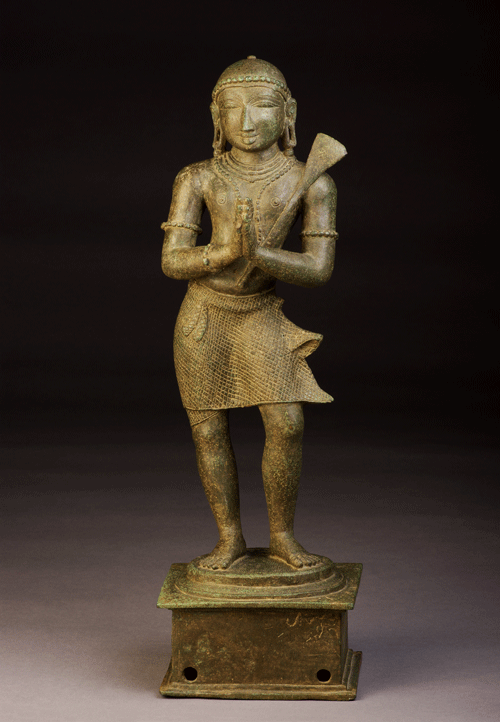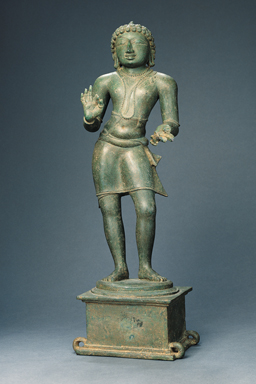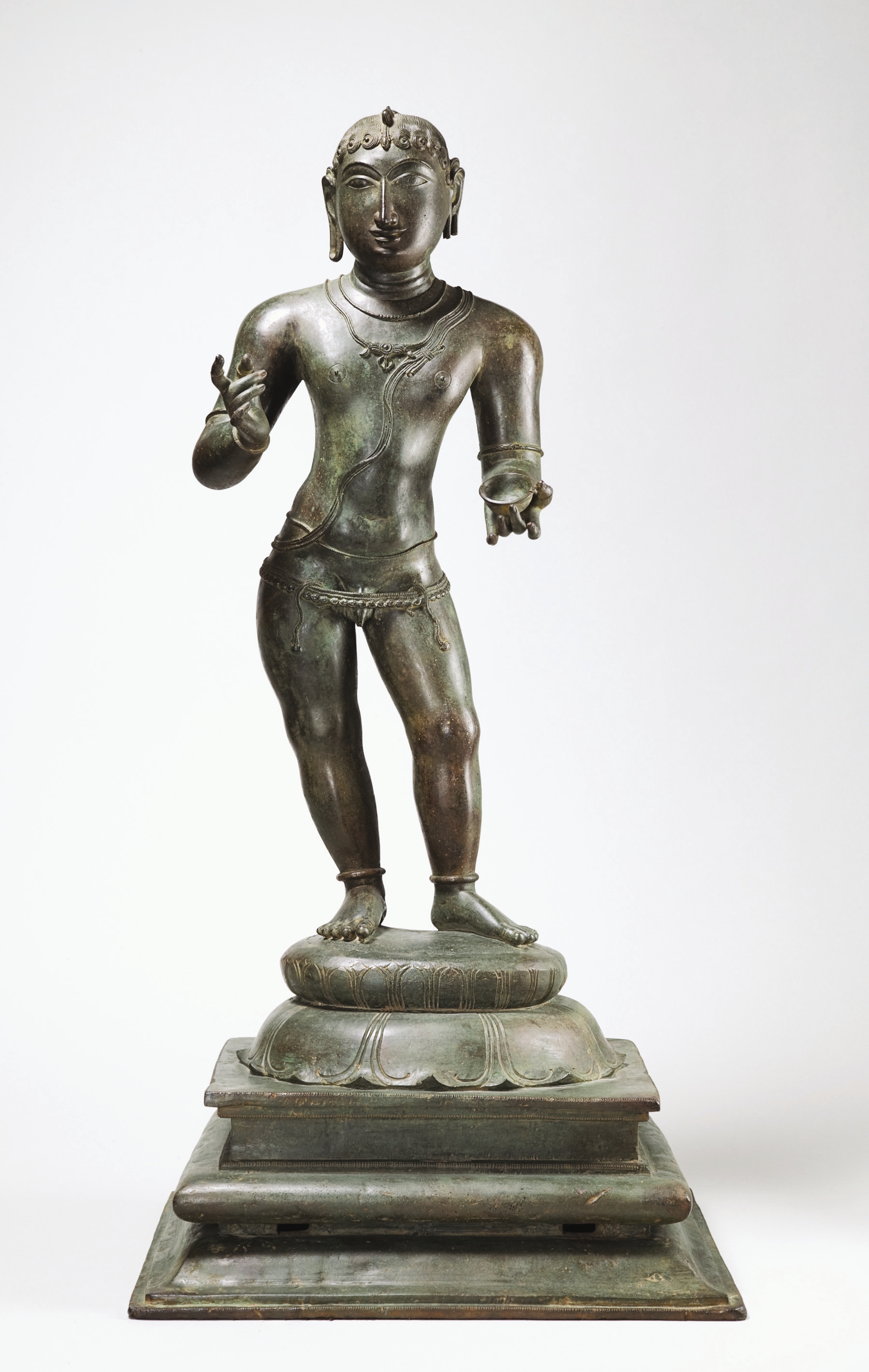Home / Bhakti: Devotion, Bronzes, and the Poet-Saints
Bhakti: Devotion, Bronzes, and the Poet-Saints
During the sixth century in south India, new devotional practices emerged around the production of portable images of gods, referred to in texts as “processional bodies,” or utsava-murti. These sculptures were employed for various special rites, ranging from daily to annual festivals. During these festivals, icons depicting the presiding deity of a temple were paraded within and outside the temple compound along with an entourage of other deities. Although generally referred to as bronze, these small-scale icons were typically cast in a special five-metal alloy, of which copper was the principal element. Through special rites, processional bronzes were empowered to embody the deity in a more accessible and anthropomorphic form than its main manifested form. This main form was typically articulated in stone and permanently installed at the center of the inner sanctum, or garbhagrha, of the temple. In Shaiva temples (temples dedicated to Shiva), for example, the central icon of Shiva is almost always an austere, cylindrical linga—meaning “sign” of the divine potency of the god—which, according to ritual texts, signifies Shiva’s highest level of being. Shaiva processional images, however, portray Shiva in the multiple forms that he temporarily embodies on earth, including Nataraja (Lord of Dance), Chandrashekhara (Lord Crowned with the Moon), Bhikshatana (Enchanting Mendicant), and Somaskanda (with Uma and Skanda), all of which are on display in this exhibition. These manifestations suggest the multi-dimensional aspects of Shiva’s single center, signified by the linga.
Accompanying the production of cast-metal icons were the building of large structural temples and the growth of communities of saints, or bhaktas. These bhaktas, who lived between the sixth and ninth centuries, traveled from one temple site to another proselytizing and composing and reciting hymns in praise of their chosen god. In both Shaiva and Vaishnava tradition, groups of saints became part of the faiths’ canons. In Vaishnava tradition (worship of Vishnu), the canonized group of twelve saints was known as alvars, or those immersed [in god], and in Shaiva tradition, the group of sixty-three saints was known as nayanmars, or leaders. Of the Shaiva saints, the four most revered were Appar, Sambandar, Manikkavachakar, and Sundarar.
The hymns of these saints, written in Tamil and usually sung, were collected and became a major source of theology in later periods. While these hymns were not necessarily based on direct contemplation of a sculptural representation of a deity, they offer personal responses that inform a cultural understanding of these Chola period bronzes. Like the figural bronzes themselves, the hymns serve to humanize the deity, making the deity more personal and accessible.
Saint Appar was the first of the Shaiva poet-saints. His title, Appar, meaning revered father, was given to him by his young contemporary, Sambandar. Appar converted to Shaivism after being miraculously cured of a stomach ailment. His hymns to Shiva are replete with gratitude and penitence, and he often admonishes himself for his earlier days as a Jain monk. His demeanor as a humble servant is reflected in bronze processional images like this one, which typically portray Appar clothed in a simple dhoti with palms joined in adoration and strands of rudraksha beads around his head and arms. He holds a hoe in his left arm, signifying his readiness to perform menial labor.
From the eleventh century on, south Indian Shaiva temples commonly had a full set of bronze images of the sixty-three principal nayanmar saints. Manikkavachakar was added to this group in the twelfth century during a period of heightened devotion to the saints. According to descriptions of his life, Manikkavachakar lived during the second half of the ninth century and was a minister in the Pandya royal court prior to devoting his life to Shiva
Whether Sambandar is depicted standing or dancing, Chola artists almost always portrayed this saint with one finger pointing toward the sky and adorned with the infant’s girdle (traditionally composed of bells). These motifs, along with a handheld drinking cup as seen in this sculpture, are suggestive of his legenary childhood transformation to Shaiva devotion. As a child, Sambandar was left alone by his father at the temple water tank crying with hunger. His father returned to find the infant with milk running down his chin and playing with a golden cup. When his father asked him who had given him the milk, Sambandar pointed upward to an image of the goddess Uma (commonly known in northern India as Parvati) beside Shiva on the temple tower. The familial intimacy suggested in this form of Shiva and Uma is reflected in Sambandar’s hymns to Shiva, which often address Shiva in a joyful and loving manner.
Saint Appar
Chola period, 13th century
Copper alloy
H. 20 in. (50 cm)
Courtesy of Pacific Straits Ventures
EnlargeSaint Manikkavachakar
Chola period, 12th century
Copper alloy
H. 19 1/4 x W. 6 3/4 x D. 4 5/8 in. (48.9 x 17.1 x 11.7 cm)
Asia Society, New York: Mr. and Mrs. John D. Rockefeller 3rd Collection, 1979.27
EnlargeSaint Sambandar
Chola period, ca. 1200
Copper alloy
H. 30 in. (76.2 cm)
Collection of Doris Wiener
Enlarge




 Share
Share